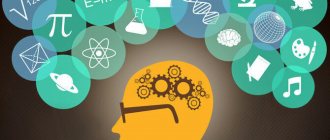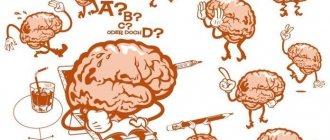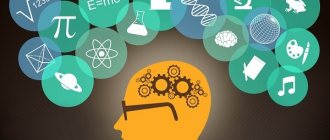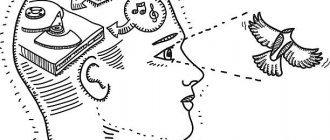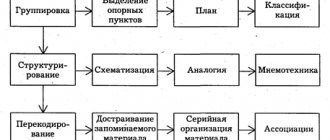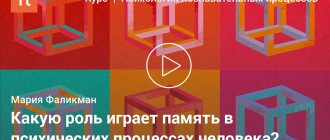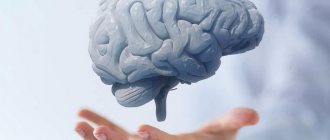Memory is a skill that is vital for every person. Without it, we would never be ourselves, would not be able to speak and would not be able to think at all. But memory is not only an indispensable skill, but also an important element of our education and intelligence.
The development of memory, attention and thinking often represents related tasks. Many of our mental characteristics directly depend on how our memory is developed. For example, the process of mastering the skills of speed reading, public speaking, or mental arithmetic is indispensable without memory. Therefore, the ability to remember information is a universal skill.
This course presents online lessons aimed at developing memory and the ability to specifically memorize material. It is ideal for you if you have just recently started thinking about improving your memory. If you already have some knowledge and want to understand the topic in as much detail as possible, sign up for our Mnemonics program.
However, this course will be useful for both. And in order to understand what exactly will be considered, we suggest learning about it in more detail.
Goals and objectives of the course
Not so far back in 2011, a study called “The Google Effect” was conducted at Columbia University, as a result of which scientists came to the conclusion that today people do not use their memory, because they always know that they can rely on the Internet. And this applies not only to some complex information, but even to the simplest things, for example, spelling rules.
And yet, a good memory is still necessary in life, work and learning. This fact is difficult to dispute, and it is unlikely that anything will change over the coming years. Based on this, we have developed our course that will help you :
| 1 | Better understand the information. Today, we are bombarded with streams of a wide variety of data from literally everywhere, in which it is easy to get confused. A good memory contributes to the development of the skill of identifying useful and necessary information and discarding everything unnecessary and unreliable. |
| 2 | Learn more effectively. An excellent memory will be useful in any field, regardless of whether you are in school, finishing graduate school or improving your qualifications. The more developed your ability to remember, the more you can know and put into practice, which in itself increases your effectiveness. |
| 3 | Develop thinking. The quality of thinking depends on the quantity and quality of neural connections in the brain. Constant perception, processing, memorization and reproduction of data have a beneficial effect on brain health, making the intellect more agile and alive. |
| 4 | Prevent diseases. As you know, with age, the human brain inevitably undergoes changes, as a result of which short-term memory deteriorates, cognitive abilities decrease, and dangerous illnesses such as Alzheimer's disease develop. Regular memory development exercises help you avoid all this. |
| 5 | Remember more. This is the most obvious advantage of developed memory. However, thanks to it, you will be able not only to remember important information or books you read, but to retain bright moments of life, pleasant emotions and joyful impressions in your head for a long time, and at the same time they will “look” clearer than the coolest photographs. |
Without developed memory, a person simply will not be able to fully function in the world. Of course, you can be content with what you have now, but why not think ahead and work on your intelligence and development of your potential today? Believe me, the time and effort spent on harmonious development will pay off with interest!
Kinds
Human memory is classified according to two main indicators: information storage period and the predominant analyzer.
- Instantaneous - lasts up to 0.5 seconds, and its essence is the reflection of data by the senses without any processing.
- Short-term – exists for short-term storage of the main elements of what is perceived. Its duration is approximately 20 seconds.
It is believed that the average volume of short-term memory is 5-9 units of information. This is exactly how many words, numbers, and images a person can reproduce within a few tens of seconds after being introduced to them once.
- Operational - a type designed to store material for a given period. After solving the task, information can be erased from RAM.
- Long-term – the ability to store information for an almost unlimited amount of time and reproduce it at any time.
Genetic memory is the transfer of information stored in the genotype by inheritance. Thus, representatives of subsequent generations from birth have a complex of unconscious actions, for example, unconditioned reflexes. This is the only type of memory that a person cannot influence through training and education.
Depending on the main analyzer of data coming from the external environment, the following types are distinguished:
- Visual – preservation and reproduction of visual images, the ability to see “before your eyes” (in the imagination) a detailed picture of what is perceived, even when it no longer affects the senses. Without developing this type of memory, you cannot become an engineer or an artist.
- Auditory – the ability to remember and reproduce a variety of sounds. It is especially characteristic of musicians, philologists, and people who study foreign languages. Any scientist, lecturer, or school teacher should be able to quickly perceive the meaning of a text he hears and read, identify the order of logical chains in reasoning, and retell it quite accurately in his own words.
- Emotional – it is also called memory for experiences. It is of practical importance for good memorization of material, because what is associated with the emotional experiences of the individual is more firmly fixed in the brain.
- Motor – especially needed by athletes and dancers to develop complex motor skills.
What is memory and remembering?
Memory is one of the mental functions and types of mental activity designed to preserve, accumulate and reproduce information.
Thus, memory is understood as a system consisting of several elements :
| 1 | Memorization is a memory process through which new information is perceived and this information is recorded in the general system of thinking and associative connections. The key function of memorization is the creation of semantic connections as a result of the work of our thinking and intellect on the content of the memorized material. Memorization is a very important process, the development of which will be given key attention in our course. However, this process is not the only one. |
| 2 | Storage is the process of systematically accumulating information in memory, including the processing and assimilation of this information. Without storing information in memory, human learning is impossible. In addition, such important abilities as thinking and speech directly depend on this process. |
| 3 | Recall is the process of representing and recognizing information stored in memory, also called memories. Reproduction can be involuntary or voluntary. Our course will pay special attention to voluntary (special, conscious) reproduction. |
Forgetting can also be highlighted. It is also a process of memory, or rather a problem of its development. The loss of the ability to reproduce learned information can be partial (reproduction incomplete or with distortion) or complete (impossibility of reproduction and recognition). You will also learn more about solving the problem of forgetting in this course.
Educational games for memory
Game 1 “Numeric Reach Revolution”
The game "Numeric Span Revolution" develops memory.
The main point of the game is to remember the numbers on the screen and dial them correctly.
In this game, numbers are displayed on the screen for a few seconds, these numbers must be remembered, then you must enter these numbers in an empty window in order. Look carefully at what numbers will be on the screen, first two numbers are displayed in order, then three numbers , then four numbers, then again there may be two numbers. Below the picture there is a board with numbers, using the mouse, you can click the numbers you need. If you remember the numbers correctly, then continue to play and score points, but if you remember three times If the numbers are not entered correctly, the game ends.
Play now
Game 2 “Fast addition reload”
The game “Fast addition reboot” develops thinking, memory and attention.
The main point of the game is to choose the correct terms, the sum of which will be equal to the given number.
In this game, at the top of the screen the task is written: add a number and the number is indicated. Below are three more numbers. You need to add the sum of these three numbers to get the given number. The game starts with a prime number and with each subsequent game this number increases, first the count goes to twenty, then to thirty and so on. Using the mouse, you can click on the selected numbers and answer. If you answered correctly, then you continue to score points and play further.
Play now
Game 3 "Letter Span"
The game “Letter Span” develops memory and attention.
The main point of the game is to remember the letters and write them correctly.
In this game, there is a black scoreboard on the screen; on this scoreboard, different letters are displayed for a few seconds, you need to remember these letters and when the letters disappear write them on the black scoreboard. The letters are located at the bottom of the screen, use the mouse to click on the desired letters and they will appear on the black scoreboard. The game starts with fewer letters, first two letters appear on the screen, then three letters, then four and so on. If you answered correctly, then you continue to score points and play further.
Play now
Game 4 "Number 3 back"
The game “Number 3 Backwards” develops memory.
The main essence of the game is to remember the sequence of numbers and compare the number on the last card with the previous card.
In this game, cards with numbers are given on the screen, the numbers on the cards open for a few seconds, then disappear and other numbers appear. You must remember the entire sequence of numbers that was shown on the screen and compare the number of the last card with the previous card. Read the question on the screen carefully. At the bottom of the screen there are two buttons “yes” and “no”. Using the mouse, you can press the button you need. If you answered correctly, then you continue to score points and play further.
Play now
Game 5 "Diamonds"
The game "Diamonds" develops memory.
The main essence of the game is to remember the order of the figures that light up on the screen and repeat it.
There are figures on the screen, they light up one by one, you need to remember the order in which these figures light up, and repeat it. With each subsequent stage of the game, the game becomes more complicated, new figures are added in larger quantities. Watch carefully the order in which the figures are lit. Using the mouse or keyboard, you can click through all the figures in order. If you answered correctly, then you continue to score points and play further.
Play now
Game 6 "Speed Comparison"
The game "Speed Comparison" develops memory and attention.
The main point of the game is to remember the previous item and compare it with the current one on the screen.
In this game, an item is displayed on the screen for a few seconds, you need to remember this item and compare it with the next item. At the bottom of the game there are two buttons "yes" and "no". Using the mouse, you can select the correct answer and click on it. If the item is the same, then you answer “yes,” if the items are different, you answer “no.” The game will end if you answer incorrectly three times. If you answered correctly, then you continue to collect points and play further.
Play now
Game 7 “Complicated high-speed movement”
The game “Complicated high-speed movement” develops memory and attention.
The main point of the game is to remember the previous item and compare it with the current one on the screen.
In this game, a drawing is displayed on the screen for a few seconds, you need to remember this drawing and compare it with the next object. At the bottom of the screen there are three buttons “yes” “no” “partially matches”. If the object is the same then you answer “yes”, if the objects are different you answer “no”, if the objects are similar you answer “partially matches”. This game is designed to increase speed .If you answer incorrectly three times, the game ends. If you answer correctly, you continue to score points and play further.
Play now
Game 8 “Memorize and call”
The game “Memorize and Call” develops memory and attention.
The main point of the game is to remember the numbers in the table and call them in ascending order.
In this game, a table with numbers is given, first the numbers are shown on the screen for a few seconds, you need to remember them, then the numbers are closed. Remember where the smallest number is located and click this cell, then click the cell where the next number goes in ascending order. With each subsequent game, the table will increase and there will also be more numbers in it. Look carefully at the order of the numbers. You can answer using the mouse by clicking on the desired cell. If you answered correctly, then you continue to score points and play further.
Play now
Game 9 “Number Reach”
The game "Number Span" develops memory and attention.
The main point of the game is to remember the previous number and compare it with the current one on the screen.
In this game, numbers appear on the screen for a few seconds; you must remember them. At the bottom of the screen there are numbers from 0 to 9. Using the mouse, you can click the numbers you need. The game starts with two numbers, then the numbers become three, four and so on, the more you play, the more difficult the game becomes. If you typed the numbers correctly, then move on to play and score points, but if you get the numbers wrong three times, the game ends.
Play now
Game 10 "Spatial speed comparison"
The game “Spatial Speed Comparison” develops memory and attention.
The main essence of the game is a series of drawings on the screen; you need to compare them with the previous drawing and answer whether it is repeated or not.
In this game, a figure appears on the screen for a few seconds, you need to remember it, then it disappears and another figure appears. Compare the figure on the screen with the previous figure. At the bottom of the screen there are two buttons “yes” and “no”. You can answer using the mouse by clicking on the desired button. If you answer correctly, then you continue to gain points and play further.
Play now
Features of human memory
We all have different abilities to remember. For some it is easier, for others it is more difficult. In addition, we remember different things in different ways. For example, one person may be good at remembering people's names and facial features, but have trouble remembering where he put something in the house. And the other, on the contrary, remembers perfectly where everything is, but does not remember the name of his neighbor. Some people prefer to use auditory and musical memory, others prefer visual memory, and some prefer to remember tactile sensations.
Memory is an ability that has individual characteristics for each person. But there are patterns of memory that are universal for all people. And it is these patterns of memory and methods of its development, as well as techniques and methods of memorization that will be discussed in this course.
Memory training in older people
In old age, brain function noticeably weakens. This is due to the fact that the ability of nerve cells to respond to external and internal stimuli decreases, as a result of which brain activity decreases. In addition to deterioration in memory, there is also a loss of concentration. But this does not mean that these processes are a consequence of the disease, or that the situation cannot be improved. Let's look at ways to train memory in older people:
- Collect puzzles . Choose the picture you like and go ahead! Just don't start with large and complex ones, because they may be difficult to assemble, and you will get tired of such an activity.
- Before you go to bed, sort through the events of your day : remember the things you did, who you met, what you talked about. The more detail you remember, the better.
- Come up with 5-10 words for each letter of the alphabet . This exercise will take time, but at the end of it you will feel the active work of your brain!
- Play board games - chess or checkers. Pay special attention to concentration when coming up with moves. Solve crosswords, scanwords. By playing for 30 minutes every day, you will activate your attention and memory process.
How to develop memory?
If we approach this issue comprehensively, we can identify a whole arsenal of techniques and actions that help a person develop, train and improve his memory. Here's what allows you to do this:
| creation of associations; |
| games with words (for example, pronunciation backwards); |
| solving puzzles and puzzles; |
| solving scanwords, crosswords, etc.; |
| creative activities; |
| regular reading of various literature (including aloud); |
| cultural and educational activities (visiting museums, exhibitions, reading clubs); |
| systematic repetition of important information; |
| writing and poetry; |
| inventing and telling stories; |
| games and tasks for attentiveness and concentration; |
| unusual activities (eg, writing with both hands); |
| learning foreign languages; |
| use of special applications (Peak, Brain+, Brain Wars, Elevate and others). |
Of course, for the development of memory (and thinking in general), adherence to the rules of a healthy lifestyle is of great importance. This includes proper nutrition, avoidance of junk food, sufficient amounts of clean water, healthy sleep, exercise, and minimizing stressful situations. All this plays a role, because the efficiency of the functioning of our body, especially the brain, depends on the overall quality of our life.
And in addition to everything, techniques aimed at this are excellent in developing memory, such as, for example, the Aivazovsky method, mnemonics, Schulte tables, etc. This can also include special courses, which often turn out to be not only no less, but even more effective than the separate use of any methods. Our course also belongs to such courses, and then we want to introduce you to what you will study.
Before that, we invite you to evaluate how well you remember information using our game. Take on the role of a restaurant head waiter and try to remember the faces, names and preferences of numerous customers to get the maximum score for your job. You can also use this game to train your memory:
Statistics Full screen
Tips for Improving Brain Function
It is in the brain that all information is stored. Its work determines how quickly we can remember the necessary information and how easily we can reproduce it later.
To improve your memory, I recommend doing the following:
- Include foods that improve brain function in your diet. Scientific research has identified foods that stimulate memory. The leader here was green tea. Omega-3 fatty acids found in sea fish, olive oil and nuts have the same properties. In addition, turmeric, sage, vanilla and rosemary have great benefits for brain function.
- Use chewing gum periodically. In the process of active chewing, blood flow to the brain improves, and this activates its work and helps to remember forgotten information.
- Sleep for at least seven hours. Chronic lack of sleep has a very bad effect not only on a person’s general well-being, but also on brain function. A person who does not get enough sleep becomes distracted and forgetful. But it is during sleep that the brain analyzes the information received during the day and filters it. Therefore, full and healthy sleep is the key to good memory.
- Meditate. Meditation helps you relax, calm down, and relieve stress. In this state, it is much easier to remove the necessary memories from your memory. If you need to remember something urgently, sit in a comfortable position, close your eyes, and breathe deeply. There should be no extraneous noise or other distractions around. This way you can extract the necessary information even from the deepest layers of memory. Regular meditation practices improve your overall mood and energize you.
- Brighten up gray everyday life. We remember very well those events that happen unexpectedly, suddenly and do not fit into the picture of our ordinary day. Therefore, change your route when going to work or to the store. Have breakfast in a cafe instead of your usual home kitchen. Add variety to your life. The brain will react to this with intense work.
Lessons on memory development
In the lessons of our course you will find useful techniques, rules and techniques aimed at increasing the level of memory development and the ability to purposefully memorize information. The method of teaching memorization methods is very simple and consists of the systematic development of memorization skills in several main areas :
Lesson 1. Attention and impression
Memory and attention are interrelated functions of human thinking. Without the ability to concentrate on the object of memorization and get an emotional return from studying this object, it is impossible to qualitatively learn the necessary material. In fact, a person’s attentiveness and interest are the main factors in their short-term memory. This lesson provides information on how to train and develop attention and memory using special techniques and exercises, as well as recommendations for getting a vivid impression of the material being studied.
Lesson 2. Associations
The main role of associations in memorization is that we link new knowledge to information we already know. To build a good association, you need to know some useful criteria for finding connections between things, as well as develop your associative thinking and creative imagination. It is equally important to learn how to build associative series and connections to stimulate figurative memory. This lesson will show you how to use the association method to remember information.
Lesson 3. Structuring
When memorizing a large amount of information, we need to structure it. Structuring information consists, firstly, in dividing information into groups and subgroups according to a certain criterion. Secondly, the ability to build logical connections between selected groups of information so that the structure is securely stored in our memory. In this lesson you will learn the principles, criteria and methods of structuring information for the best memory.
Lesson 4. Repetition
Human memory, unlike computer memory, tends to be modified over time. In other words, memory is a dynamic process. How long we want to store certain information in our memory is related to the repeated replay of this information in our minds. This lesson will provide special techniques for improving the memorization of information by repeating what has been learned.
Lesson 5. Mnemonics
Mnemonics are special methods of memorizing certain types of information, based on the characteristics of the human psyche, as well as on the four rules of memorization that were given in previous lessons. Knowledge and use of special mnemonics will allow you to better remember digital information, specific texts and terms, names, faces and surnames, foreign words, expressions and much more. This lesson will cover the basics of mnemonics, and also describe the basic techniques and methods for memorizing various types of information.
Lesson 6. Memory training
Despite the fact that understanding the laws of human memory can improve the memorization of necessary information, without special exercises it is difficult to achieve high results. As in sports, music, speed reading, public speaking and acting, proper training is needed to develop memory. This lesson will tell you how you can effectively train the ability to voluntarily memorize, and will also provide exercises, techniques, programs, free online games, methods and techniques for developing visual and auditory memory.
In addition, in our course you will find auxiliary tools that will help you better master the topic of memory development, understand the topics that interest you most, and achieve even more impressive results:
Books and textbooks
In this section we will look at some of the best works designed to train and improve the skill being studied. They are extremely effective, efficient and useful books for memory development, because... contain a huge number of various techniques, techniques, examples and exercises for training the ability to remember information. All of them will be useful to those who are interested in working on themselves and seeking to improve their personal productivity.
Educational games
Just as an athlete must improve his skills with daily training, so everyone who wants to have an excellent memory must skillfully hone this useful skill. This section contains specific material - online and other games for children and adults that will help develop and maintain attention, the ability to memorize and reproduce information.
Additional materials
Our course is relatively small, and, of course, it is very problematic to fit all the important and necessary information into it. But it is undoubtedly needed, and therefore we propose to deepen our knowledge on the topic under consideration. In this section you will find a small selection of useful materials (namely, effective training programs and articles) that will help you better study individual issues and understand everything.
And now a few words about how to take this course correctly.
Learning speed reading is absolutely not a pain
Teaching speed reading techniques is based on a serious scientific basis. It was developed with the participation of psycholinguist V. Leontyev and psychologist L. Grimaki.
This truly effective technique, where science and methodology is involved, significantly improves the principle of speed reading and memory development.
Experts say that there are five shortcomings in the traditional reading method that prevent people from mastering speed reading, and memory development is significantly reduced:
- How to develop memory and attention if users of the traditional reading method often use backward eye movement (regression) to re-read text that is not entirely clear? How can memory and attention develop in such a rhythm?
- Lack of a flexible reading program, when texts are read equally slowly, even if some of them require quick reading.
- The main obstacle to fast reading is articulation, that is, the sound of the text while a person reads it to himself. Many people mentally recite the text while they read. This defect takes up too much of the reader's time. This is the most difficult defect to correct, but thanks to the speed reading program, it is corrected over time.
- The fourth disadvantage is that people have a small field of view when reading. This is the area that is perceived by the eyes at the fixation (stop) stage.
- Lack of attention, which is a catalyst for the reading process. Without attention there is no fast reading. That’s why memory development and speed reading are so interconnected. After all, memory cannot exist without attention either.
How to take the course?
The presented course is structured in such a way that it gradually covers increasingly complex topics. Therefore, even if you are confident in yourself and your abilities, we recommend that you do not miss a single lesson and take them exactly in the order in which they are presented. Your results will depend on this.
As you already know, the course consists of six lessons. As practice shows, it is most effective to take one lesson every 1-2 days. This contributes to a full perception, analysis and understanding of the material. And practical tasks will help you start practicing from the very first day. Remember to devote adequate time and attention to the exercises and tasks. In general, there is nothing complicated in the course, so we can only wish you good luck.
Other interesting tasks
Teaching children new words will be easier with visual games. Often similar methods are used to study foreign languages. Words unfamiliar to the baby are written on small pieces of paper and posted around the house on appropriate things. This way the child will remember the names of objects and learn to recognize them in the future.
There is another effective way that helps you quickly learn foreign words. They should be written down several times on a piece of paper. Every day you need to learn new words, increasing their number. This training will help students of different school grades learn a foreign language.
Development of the brain hemispheres: brain exercises
Watch this video on YouTube
There are several more original exercises for memory development:
- Couples. Games that involve searching for identical illustrations will help increase concentration and improve the process of memorizing and retaining information. 16-20 cards are laid out on the table. They are turned over one by one and memorized in order to find identical pairs and put them aside. Such simulators can be found on the Internet online or downloaded to your computer for daily training.
- Pictograms. Such icons are found everywhere in our lives: in phones, books, brand logos. Pictograms serve as an excellent tool for memorizing information data and strengthening memory. You should choose a sentence and draw an icon for each word. For example, the verb “to see” can be depicted as an eye, and “to inhale” as a nose and a stream of steam. This game is suitable for both the development of a child and an adult.
- Mind maps. This technique is also called “mental maps” or “flash cards”. The task is reminiscent of pictograms, since they also need to be drawn. However, it is more effective and helps you memorize even entire books. A task or problem is depicted in the center of a sheet of paper. The main sections with numbering are set aside in the form of thick branches. Reveal details of tasks on thin branches using icons, keywords and color marks.
Long-term memory disorders
The inability to encode incoming information in the correct way is a violation of human long-term memory , which can be corrected. A more complex disorder is amnesia. This pathology worsens the functioning of the hippocampus and occurs against the background of a very strong emotional shock or traumatic brain injury.
Causes of memory impairment
Long-term memory is impaired due to physiological problems:
- acute or chronic intoxication - alcohol, drugs, medications (or poisoning with other poisons);
- cerebrovascular accidents due to atherosclerosis, stroke;
- brain tumors;
- Alzheimer's disease;
- mental retardation due to genetic abnormalities, pregnancy pathologies.
Mental causes of memory impairment include:
- prolonged stress;
- neurotic state;
- overwork, sleep disturbance;
- intense emotional and intellectual stress;
- psychological trauma;
- depression.
Physical or emotional exhaustion can also cause difficulties with remembering information and memory lapses.
Symptoms
Characteristic symptoms suggest a violation of long-term memory:
- a person has difficulty remembering - it is difficult for him to save and remember dates, poems, and other material;
- it is not possible to remember what happened in the past - not too long ago and many years ago, there are gaps in memory;
- consciousness is confused, cause-and-effect relationships are broken;
- forgetfulness occurs in familiar situations (a person forgets to do what was planned);
- intellectual abilities decrease and performance decreases;
- inattention is noticeable, there are difficulties with concentration and maintaining attention;
- Confusion arises in familiar situations.
Manifestations of long-term memory disorders can occur in isolation from others and increase over time, but sometimes several symptoms occur at once in a short period of time.
Problems with long-term memory affect all key aspects of a person's life. Forgetfulness leads to misunderstandings with loved ones, problems at work due to poor performance of tasks and inability to concentrate. With amnesia, a person cannot remember important facts about himself, his own life, against the background of this, social maladjustment arises.
Cicero or Roman room method
Experts often use a method called the “Roman Room”, which was used by Cicero. It involves learning something at home. When reproducing, a person remembers the room with its elements, and at the same time facts and events emerge. A simple way to link information concepts to objects in a room consists of a number of steps.
- Creation of a matrix including basic images. To do this, you can take any room: an apartment, an office, a store, as well as part of the city. The sequence of passage through consciousness of those objects to which elements of information are attached is important.
- We fix the route to eliminate chaos from the process and make memorization logical and meaningful.
- Linking information to well-known images from which a coherent narrative can be made.
- We apply the rules of memorization.
- We associate new images with bright places, making them clear.
- We turn big into small and vice versa.
- We add dynamics and move the image.
Recommendations for developing memory using the Cicero method are given by training first of all. After all, this is a simple and effective remedy that will be enough for some people. The workout can be done anywhere.
Meditation
Another method for improving long-term memory functions is meditation. It allows you to relax and concentrate at the same time. Thanks to it, not only attention, observation and memorization are improved, but also the level of stress is reduced, the immune system is strengthened, depression goes away, and the risk of developing diseases of the cardiovascular system is significantly reduced.
A meditation assistant is the Nimbus Mind app. There you can find many relaxation programs, music, and sounds of nature. This is a great investment in healthy sleep and relaxation.
A little history
The processes of formation and consolidation of memories have been of interest to scientists for a long time. Even Aristotle in Ancient Greece hypothesized that objects emit material particles, then they penetrate the head and leave an imprint on the brain, like on clay.
Scientists began actively studying the neurophysiological foundations of memory at the beginning of the 20th century. I. Pavlov identified the main mechanisms for the formation and consolidation of new connections. The physiologist described the conditions for the emergence of connections, the prerequisites for their retention in the doctrine of higher nervous activity.
Neurophysiologists paid a lot of attention to the mechanisms of information transfer from short-term storage to long-term storage in the mid-20th century, but this issue still remains controversial.
In 2011, American scientists recreated the circuit of neurons that is the basis of long-term memory. Experiments conducted by the researchers showed that the incoming signal forms strong connections within 10 minutes, which do not disintegrate for a long time and remain in the brain structures throughout life.
